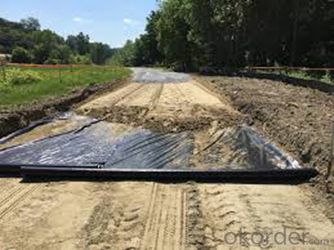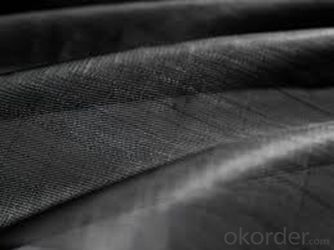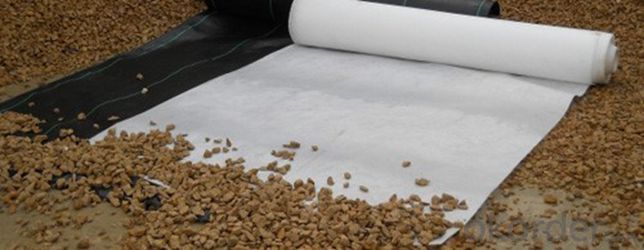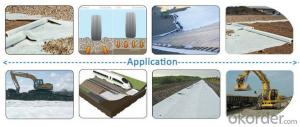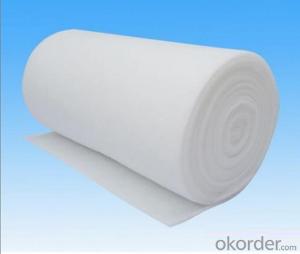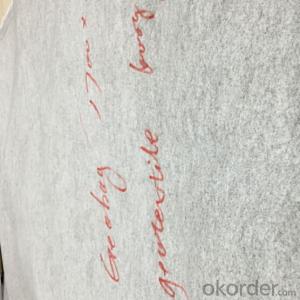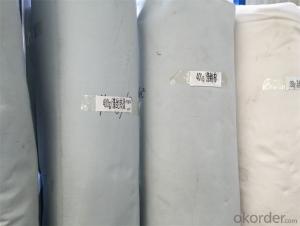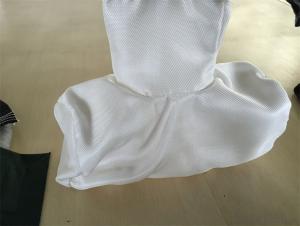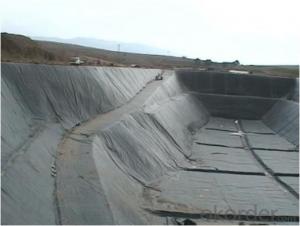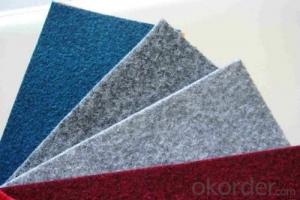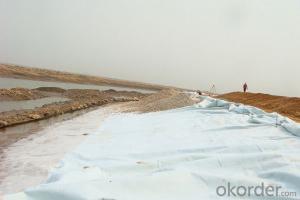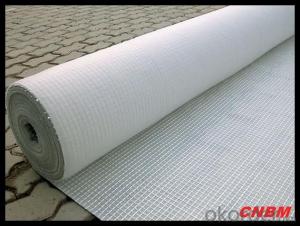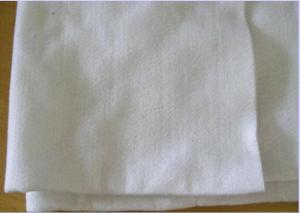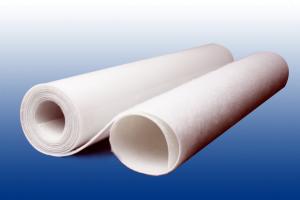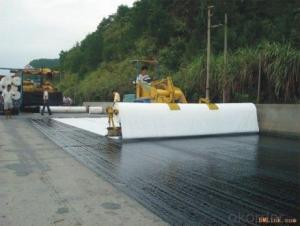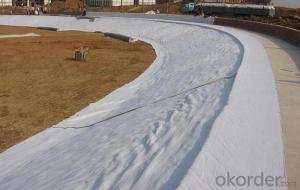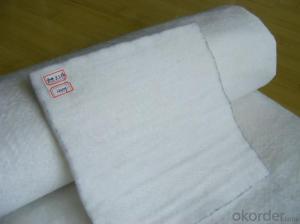Que Es Geotextil - Nonwoven Geotextile for Construction & Real Estate from China
- Loading Port:
- China main port
- Payment Terms:
- TT OR LC
- Min Order Qty:
- 5000 m²
- Supply Capability:
- 1000000 m²/month
OKorder Service Pledge
OKorder Financial Service
You Might Also Like
Specification
Product introduction:
Ought to say again geotextiles, it is by the synthetic fiber woven by acupuncture or the permeability geosynthetic materials. Geotextile into nonwoven fabric and nonwoven geotextile are spinning. Geotextile excellent filtering, isolation, and strengthening protection, tensile strength, high permeability, high temperature resistant, fight frozen, aging resistance, corrosion resistance. By filament or nonwoven geotextile are short fiber through different equipment and technology, in order to make such technology in acupuncture different fiber interacting with each other, the fixation tangles fabrics, soft, Java, thick fabric, dull color.gives, in order to achieve different thickness meets the requirement of nonwoven geotextile can have very good, very good fabric clearance, soft, because fiber attached with certain tensile ability and good adaptability, also has the deformation of drainage capacity, good plane surface soft clearance has very good friction coefficient increases soil particles and can prevent the adhesion ability of tiny particles through the erosion and prevent particulate out redundant moisture soft surface, good protection ability. According to the length of the wire into nonwoven geotextile or short silk filament nonwoven geotextile. They can have very good filtering, isolation, reinforcement, protection, is a widely used geosynthetic materials. Filament tensile strength than short silk, can choose according to the specific requirements.
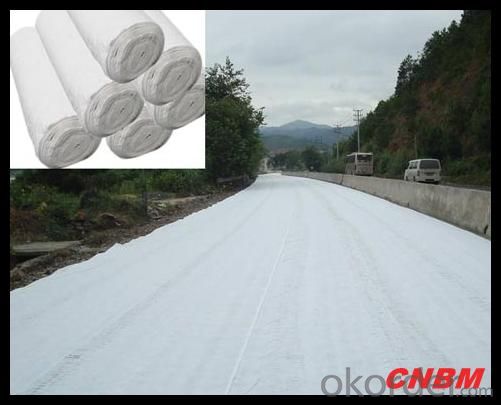
Packaging & Shipping
Packing: PLASTIC FILM INSIDE, AND WOVEN BAG OUTSIDE
Shipping: About 15 days after receipt the deposit
geotextile fabric
permeability,filtration,easy for construction
ISO and CE certificate
Good quality and competitive price
Our Service
Quality assurance
1.On a regular basis or as per your request,we entrust national testing agencies to conduct quality inspections
2. Strictly in accordance with the ISO9001-2008 international quality system standard,we monitor and manage the whole process throughout production,quality testing,and measurement to ensure product quality
3. For quality-related construction delay or substandard construction(except for damage or losses due to customer’s responsibility or irresistible natural disasters),we have refunding,replacement,and repair services.We will respond to customers’ feedbacks on quality issues within 24 hours.
After-sales service
1.In order to provide customers with comprehensive technical support,we will provide technical and other related information upon request in a timely manner.
2.In required,we will appoint specialized technicians to the construction site to give technical trainings to construction people,and offer technical guidance throughout the whole construction process.
3.For damage due to shipment and delivery,after we receive the complaint,we will check the issure through provided pictures and videos.If our responsibility is confirmed,we wil offer free replacement.
4.When the construction is completed,as your request,our technical staff may participate in the final acceptance.
FAQ:
Q: What kind of payments does jenor support?
A: T/T, L/C, Cash are accepted.
Q: Do you charge for the samples?
A: Accordeing to our company policy, the samples are free, we only charge the freight fee. And we will return the freight fee during the next order.
Q: Can you produce according to customers' design?
A: Sure, we are professional manufacturer, OEM and ODM are both welcome.
Q: Do you have other products?
A: Yes, please check the pictures:
- Q: What are the different geotextile installation techniques for roadways?
- There are several different geotextile installation techniques for roadways, including the overlay method, the trench method, and the sandwich method. - The overlay method involves placing the geotextile directly on top of the existing soil or subgrade before adding the new road material, such as asphalt or concrete. This technique helps to separate the soil layers and prevent the mixing of materials, providing stability and reducing the risk of road failure. - The trench method involves excavating a trench along the road alignment and placing the geotextile in the trench before backfilling it with soil or aggregate. This technique is commonly used for drainage applications, as the geotextile acts as a filter to prevent fine particles from clogging the drainage system, while allowing water to flow through. - The sandwich method is a combination of the overlay and trench methods. It involves placing a layer of geotextile between the existing soil and the new road material, as well as placing another layer of geotextile on top of the new road material. This technique provides additional reinforcement and separation, enhancing the overall performance and durability of the roadway. Overall, the choice of geotextile installation technique depends on the specific requirements and conditions of the road project, such as soil type, traffic load, and drainage needs.
- Q: Split silk geotextile and filament geotextile relative price which is cheaper
- Split silk geotextile and filament geotextile relative price which is cheaper
- Q: Geotextile universal testing machine with 20kn enough?
- Conventional geotextile mechanics test using 20KN test machine on it, individual users need to do some large range of mechanical tests, our company also has some customers choose 50KN universal testing machine. The specific choice of 20KN or 50KN to see if you are on the equipment requirements upwards compatible.
- Q: How do geotextiles improve the performance of pavement structures?
- Geotextiles improve the performance of pavement structures by providing reinforcement, filtration, and separation functions. They enhance the pavement's strength and stability by distributing the load more evenly, reducing rutting and cracking. Additionally, geotextiles help to prevent the mixing of different soil layers, minimizing the potential for contamination and maintaining the long-term integrity of the pavement.
- Q: What are the design considerations for geotextile applications?
- Some of the key design considerations for geotextile applications include the type of geotextile material to be used, the required strength and durability, the desired permeability and filtration properties, the potential for installation damage or degradation, and the compatibility with other materials and environmental conditions. Additionally, factors such as site-specific soil characteristics, water flow rates, loadings, and the intended function of the geotextile also need to be taken into account during the design process.
- Q: Will the HDPE geomembrane, non-woven geotextile re-examination to detect what project? Is there a basis for testing? Thank you, hurry! The The
- CBR top breaking strength, vertical permeability coefficient ,,
- Q: Can geotextiles be used in agricultural drainage systems?
- Yes, geotextiles can be used in agricultural drainage systems. Geotextiles are permeable fabrics that can be installed to improve soil drainage by allowing water to pass through while preventing soil erosion. They can be used as a filter around drainage pipes to prevent soil particles from clogging the system, thus enhancing the effectiveness and longevity of the agricultural drainage system.
- Q: Are geotextiles suitable for use in dam construction?
- Yes, geotextiles are suitable for use in dam construction. They can act as filters, separators, and reinforcements, providing erosion control, soil stabilization, and increased strength to the dam structure. Geotextiles can help prevent seepage, improve drainage, and enhance the overall performance and longevity of the dam.
- Q: How do geotextiles help in reducing the settlement of structures on soft soils?
- Geotextiles help in reducing the settlement of structures on soft soils by providing a stable base and improving soil characteristics. They distribute the load more evenly across the soil, increase its shear strength, and prevent excessive settlement by acting as a reinforcement layer. Additionally, geotextiles can also allow for better drainage, which helps in dissipating excess pore water pressure and reducing the risk of settlement.
- Q: How are geotextiles used in civil engineering projects?
- Geotextiles are used in civil engineering projects to provide reinforcement, filtration, drainage, and separation functionalities. They are commonly used to reinforce soil, especially in retaining walls and embankments, to prevent erosion and stabilize the ground. Geotextiles also act as a filtration layer, allowing water to pass through while preventing the migration of soil particles, which helps to maintain the integrity of structures and prevent clogging. Additionally, they can be used for drainage purposes, efficiently removing excess water from the soil and preventing water accumulation. Furthermore, geotextiles are used to separate different layers of soil or aggregate materials, preventing them from mixing and maintaining their individual properties. Overall, geotextiles play a crucial role in improving the durability, stability, and performance of civil engineering projects.
Send your message to us
Que Es Geotextil - Nonwoven Geotextile for Construction & Real Estate from China
- Loading Port:
- China main port
- Payment Terms:
- TT OR LC
- Min Order Qty:
- 5000 m²
- Supply Capability:
- 1000000 m²/month
OKorder Service Pledge
OKorder Financial Service
Similar products
Hot products
Hot Searches
Related keywords





